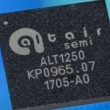

Six small to medium-sized enterprises (SMEs) from across the UK have been awarded a share of £50,000 (€58,000) funding by Future Cities Catapult, the UK Government-supported centre of excellence in urban innovation. (more…)
February 20, 2017
Posted by: Avadhoot Patil

Altair Semiconductor, a provider of LTE chipsets, has introduced the ALT1250, a narrowband CAT-M1 and NB1 (NB-IoT) chipset that aims to redefine the cellular IoT connectivity space, featuring global band support, advanced security and location capabilities far surpassing the functionality of existing chipsets. (more…)
February 16, 2017
Posted by: Avadhoot Patil

By 2020 it is estimated that the global Internet of Things (IoT) market will have grown to more than $1.7 trillion. According to a study by Gartner, by the end of this year alone the number of IoT devices on the planet will have reached more than 4 billion. (more…)
February 10, 2017
Posted by: Avadhoot Patil

The IoT era looks set to bring significant changes to industries which have, typically, been slower to embrace disruptive technologies. One such sector is construction, in which IoT technologies have the potential to not only improve efficiencies at key stages of the design and build of structures, (more…)
January 17, 2017
Posted by: Avadhoot Patil

RPMA (Random Phase Multiple Access) LPWAN (low power wide area network) technology was designed from the bottom up to optimise wide area connectivity for Machine-to-Machine and Internet of Things (M2M and IoT) devices. (more…)
January 10, 2017
Posted by: Avadhoot Patil

Dermot O’Shea, joint CEO of antenna specialists Taoglas, is optimistic about several key aspects of the Internet of Things (IoT) in the year ahead. (more…)
January 4, 2017
Posted by: Avadhoot Patil

2016 has been a busy year for telecoms operators in the Internet of Things (IoT) market, most notably in low-power, wide-area (LPWA) technologies as narrowband IoT (NB-IoT) and LTE-M (long-term evolution to 4G, machine to machine) approach full commercial deployment. (more…)
December 28, 2016
Posted by: Avadhoot Patil

Difficult Second Album, Sophomore Slump, Second Year Blues – it’s not easy maintaining success. Happily, says André Stoorvogel of Rambus Bell ID, following its breakout year in 2015, the mobile payments industry has seen continued innovation and growth in 2016. (more…)
December 22, 2016
Posted by: Avadhoot Patil

Modern life is demanding. Better connectivity means people now want everything on-demand in all aspects of their lives. Businesses have been tasked with keeping up, delivering the products and services required, without compromise, (more…)
December 21, 2016
Posted by: Avadhoot Patil

SNS Research has released a new 239-page report, The LPWA (Low Power Wide Area) Networks Ecosystem: 2017 – 2030 – Opportunities, Challenges, Strategies, Industry Verticals & Forecasts. (more…)
December 13, 2016
Posted by: Avadhoot Patil